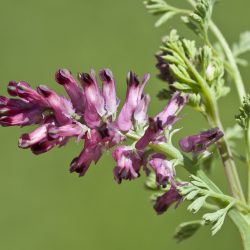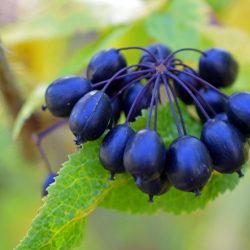What is Alfalfa?
Alfalfa, more commonly known as cultivated alfalfa (Medicago sativa L.), is a remarkable plant in the plant kingdom. Native to warm temperate regions, this species belongs to the Fabaceae family, one of the most diverse and important in terms of varieties. Historically, it has played a key role in agriculture and animal feed, thanks in particular to its exceptional nutritional properties.
What are its botanical attributes?
A little history
Alfalfa gradually spread to Central Europe, Siberia and China. Characterised in particular by its resistance to cold and low yield, this first variety is known as Medicago falcata. It was contemporary with another European species, M. sativa, so named precisely to specify its essentially cultivated character(sativus in Latin). The Greeks, Romans and then the Arabs helped to spread the plant in East and North Africa, as well as in Spain and France.
At the beginning of the 16th century, the meeting of these two varieties of alfalfa, a plant that hybridises easily, gave rise to the so-called “Flemish” variety, from which descend the alfalfa currently cultivated in agriculture for animal nutrition.
The ancient Chinese also ate it as a vegetable. In North Africa, the Arabs called it “al-fac-facah”, which means “father of all foods”. They fed it to horses to increase the nutritional value of their food and make them stronger. Not only is it one of the plants with the highest concentration of phytoestrogens and phytosterols, it is also one of the richest known sources of minerals, thanks to its roots that go deep into the soil, absorbing nutrients that other plants cannot reach.
What are the benefits of this plant?
Medicago sativa L., better known as alfalfa, has major ecological, nutritional and therapeutic benefits.
Ecologically, alfalfa plays a key role in fixing atmospheric nitrogen, thereby reducing the concentration of nitric nitrogen in the soil. This process helps to limit nitrate leaching, thereby protecting the water table. Its Total Nitrogen Matter (TNM) content varies from 14% to 29% of Dry Matter (DM), depending on various factors such as growth stage and harvesting method.
Alfalfa even outperforms soya meal in terms of amino acid composition. It is rich in proteins, particularly Rubisco, and a wide range of vitamins (B, C, D, E, A), and is used in dietetics and pharmaceuticals.
Therapeutically, alfalfa’s phytoestrogens, particularly the flavonoids, have properties similar to oestradiol, so they are better absorbed by hormone receptors. The saponins present reduce cholesterol absorption, limit the progression of cancer cells and have antioxidant effects. Alfalfa is also recognised for its role in the treatment of diabetes, stimulating the incorporation of glucose in the form of glycogen into the muscles and possessing properties similar to insulin.
Other therapeutic properties include anti-bacterial, anti-fungal, anti-haemorrhagic and haemostatic effects. It may even modulate the action of anticoagulant and lipid-lowering drugs.
As a forage plant, alfalfa is essential for feeding livestock, providing a rich source of protein and carotene.
As far as toxicity is concerned, alfalfa is generally safe at the recommended doses, although cases of allergy, gastrointestinal problems, dermatitis and arthralgia have been reported.
What are the main pharmacological properties of Alfalfa?
Alfalfa is attracting interest because of its potential therapeutic benefits. However, the scientific validity of all its uses has not been established. Animal studies suggest that alfalfa seed meal may lower cholesterol and triglyceride levels without altering ‘good’ cholesterol, but human research remains limited and inconclusive. As far as the menopause is concerned, the phytoestrogens contained in alfalfa may reduce hot flushes, but the evidence is insufficient. In phytotherapy, alfalfa is used to treat general fatigue,anaemia and other conditions, such as osteoporosis, due to its high mineral content, particularly calcium. It is also studied for its anti-cholesterol and diuretic properties, as well as for its potential in regulating blood sugar levels and eliminating toxins due to its chlorophyll content.
Hormonal properties
It is considered to have an indirect anti-androgenic and anti-LH effect. Alfalfa has also been shown to have an effect on menopausal climacteric disorders (hot flushes).
The oestrogenic activity of certain plants, including alfalfa, has been recognised in vitro and in vivo by ANSES. This activity is attributed to the presence of coumestanes (such as coumestrol and 4-methoxycoumestrol) and isoflavones (genistein, daidzein), which bind to oestrogen receptors and show uterotrophic activity. Plants such as soya, clover, hops, kudzu, liquorice, flax and fennel, which contain isoflavones, belong to the Fabaceae and Papillonaceae families. They contain around 70 aglycones and 40 glycosides, with a high concentration in seeds and dried fruit. The lignans present in many fruits, vegetables, tea and coffee, and in particular in flaxseed and wholegrain cereals, are also important sources of phytoestrogens.
Estrogenic effects include an increase in the epithelial base and stromal proliferation of the uterus, as well as an increase in serum prolactin levels. Anti-estrogenic effects have been observed in animals exposed to coumestrol-enriched diets, leading to anovulation and an inability to synthesise LH after oestradiol injection. In addition, multiple hormonal effects have been described in young males, including a decrease in serum testosterone and estradiol levels, and an increase in prolactin levels.
In summary, alfalfa and other plants in the Fabaceae family have potential oestrogenic properties that can influence various hormonal processes in animals.
Metabolic properties
Cholesterol regulation, with improved lipid profile:
A study shows that alfalfa saponosides inhibit intestinal cholesterol absorption by forming an insoluble complex. This results in a reduction in the ratio of total cholesterol in plasma to HDL cholesterol, as well as an increase in faecal excretion of steroids and bile acids.
In addition, the flavonoids and phytoestrogens present in alfalfa act synergistically to exert an antioxidant action on LDL cholesterol. Alfalfa saponins have been shown in vitro to modulate mRNA expression of genes involved in cholesterol metabolism. The beneficial effects of alfalfa saponins include significantly reducing intestinal cholesterol absorption, limiting the progression of cancer cells and their antioxidant effect. In addition, it has been suggested that Medicago sativa.L may counteract the anticoagulant action of similar drugs. These effects complement those of lipid-lowering drugs.
Phytosterols, naturally present in plants, are known to reduce blood cholesterol levels by competing with cholesterol in the intestine. Claims indicating that phytosterols reduce blood cholesterol and that this reduction may reduce the risk of cardiovascular disease are authorised on products enriched with phytosterols. However, concerns have been raised about the risks and benefits of consuming these products.
According to the Agence nationale de sécurité sanitaire de l’alimentation, de l’environnement et du travail (ANSES), although phytosterols help to reduce blood cholesterol, current data do not allow us to prove their benefit in preventing cardiovascular disease or to consider foods enriched with phytosterols as an appropriate means of prevention on a population scale.
Blood sugar regulation
Its use has been confirmed in vivo in diabetic models. In particular, alfalfa is thought to stimulate the incorporation of glucose in the form of glycogen into abdominal muscle, and to possess properties similar to those of insulin.
Alfalfa has traditionally been used as a treatment for diabetes. This ability has been demonstrated in vivo using diabetic mouse models. It is thought that alfalfa specifically promotes the incorporation of glucose in the form of glycogen into abdominal muscle, giving it properties similar to those of insulin. These findings are supported by references such as Malinow (1981), Gray (1997) and Hwang (2001).
More recently, in 2009, the National Centre for Complementary and Alternative Health sponsored a clinical trial to investigate the use of alfalfa and other plant extracts in regulating insulin levels. Initial evidence suggests that a compound called NIC5-15, extracted from soya, alfalfa, pine cones and pine bark, may prove to be a beneficial extract for regulating blood sugar levels.
In summary, alfalfa is recognised for its potential in the traditional treatment of diabetes, supported by studies on mouse models. In addition, recent research suggests that a compound derived from alfalfa could help regulate blood sugar levels, opening up new prospects for the treatment of diabetes.
Alkalizing mineral-modulating activity
Alfalfa is recognised for its remineralising properties, although clinical support remains limited, based mainly on extrapolations from general scientific knowledge. However, empirical observations, preliminary clinical trials and specific medical cases confirm some of its exceptional therapeutic properties.
As a tonic and remineraliser, alfalfa has a stimulating effect on the nervous system. It is effective in combating decalcification, general tiredness and sporting events, as well as preventing muscle strains and cramps. Menopausal women and people suffering from arthritis, rheumatism and gout can particularly benefit from its beneficial effects.
Finally, as a detoxifying plant, alfalfa is invaluable for detoxification cures. Its powerful purifying effect on the body’s tissues makes it an essential asset for those wishing to carry out an in-depth purification. It also contains an interesting combination of minerals, trace elements and vitamins from the B, C, D, E and A groups, making it a complete nutritional supplement.
Antifungal and antibacterial
What’s more, thanks to its high chlorophyll content, a substance with properties comparable to those of haemoglobin in the blood, alfalfa is particularly effective in the treatment of infectious diseases. It is useful for treating a variety of conditions, including bronchitis,asthma, prostatitis, bladder problems, skin disorders and viral and bacterial diseases in general.
Antibacterial products include molecules that selectively target the metabolic pathways of bacteria, without generally causing toxic effects in higher organisms. These products can be of synthetic (pharmaceutical) or natural (plant) origin. The exact mechanism of the antimicrobial effects of polyphenols, such as flavonoids, remains complex, but certain hypotheses have been put forward, including the inhibition of microbial extracellular enzymes, the sequestration of substrates necessary for microbial growth, and the chelation of metals such as iron.
Flavonoids have a wide range of antibacterial activity, inhibiting the growth of different bacterial strains such as Staphylococcus aureus, Escherichia coli, Enterococcus feacalis, Enterobacter cloaceae, Heliotropium sinuatum, Proteus mirabilis, and many others. Each flavonoid acts in a specific way on certain bacteria, showing a variety of effects.
In terms of antifungal activity, flavonoids have been shown to be powerful against a variety of fungal agents, such as Microsporum canis, Microsporum gypseum, Trichophyton mentagrophytes and Candida zeylanoides. However, more research is needed to fully understand their antifungal action, given the wide diversity of moulds and yeasts.
The composition of flavonoids can vary depending on a number of factors, including culture conditions, which influence their antibacterial activity. In addition, certain studies have begun to elucidate the mechanisms of action of flavonoids on microorganisms, particularly with regard to their interaction with the DNA gyrase of Escherichia coli.
Are there any precautions to be taken when using Alfalfa?
Alfalfa, a plant rich in chlorophyll and flavonoids, offers various health benefits, including antimicrobial properties against bacteria and fungi. However, there are some important contraindications and precautions for use.
Firstly, alfalfa is not recommended for people with hyperoestrogenism or hormone-dependent cancers such as breast or uterine cancer. It should also be avoided by people suffering from immune dysfunction, as it can cause reactivation of systemic lupus erythematosus (SLE ) and other diseases due to its high saponoside content.
As far as drug interactions are concerned, alfalfa may interact with certain anticoagulant drugs due to its vitamin K content, which could counteract the anticoagulant effect of these drugs. What’s more, the effects of alfalfa on the regulation of cholesterol metabolism could add to those of lipid-lowering drugs.
As regards precautions for use, it is recommended not to consume large quantities of ungerminated seeds to avoid any undesirable effects.
It’s also important to note that alfalfa is not recommended for people who have already suffered from systemic lupus erythematosus or for those with a weakened immune system.
Finally, although adverse reactions to alfalfa are rare, in some cases reactions such as dermatitis and gastrointestinal problems have been reported. In addition, interactions may occur when alfalfa is taken in combination with other medicinal plants or supplements, particularly with regard to regulating blood sugar levels. These interactions could add to the effects of other plants or medicines with a hypoglycaemic effect.
How should Alfalfa be taken and at what dosage?
Alfalfa dosage varies according to the form in which it is consumed. However, the data available remains limited, which makes it difficult to recommend a precise dosage.
In its dry form, alfalfa is generally taken as a dietary supplement, usually in the form of a powder in capsules. However, there is no widely accepted standardised dosage for this form.
In liquid form, there are two popular options.Standardised fresh plant fluid extract allows you to take 5 to 10 ml a day, diluted in a glass of water. An alternative is the mother tincture, with a recommendation of 20 to 25 drops to be taken 1 to 2 times a day, also in a glass of water.
We recommend taking a three-week course of alfalfa twice a year. If you opt for the liquid extract, we suggest taking it three times a day, just before meals, taking 20 to 25 drops a day, diluted in a little water, fruit juice or tea.
When using standardised alfalfa preparations, it is essential to follow the recommended dosages specific to each product.
You should also bear in mind that alfalfa can be eaten in a variety of ways, whether in a salad, as sprouted seeds or as an extract. Which way you eat alfalfa will depend on your personal preferences and the specific recommendations for the products you use.
Medical literature and clinical trials
- Gray A.M. et al, Pancreatic and extra-pancreatic effects of the traditional anti-diabetic plant, Medicago sativa (lucerne), Br J Nutr, 1997
- Hwang J. et al, Soy an alfalfa phytoestrogen extracts become potent low-density lipoprotein antioxidants in the presence of acerola cherry extract, J Agric Food Chem, 2001
- Sadowska B. et al, New pharmacological properties of Medicago sativa and Saponaria officinalis saponin-rich fractions, addressed to Candida albicans, J Med Microbiol, 2014
- Liang X.P. et al, Effects of alfalfa saponin extract on mRNA car expression of Ldlr, LXRα, and FXR in BRL cells, J Zhejiang Iniv Sci B., 2015
- Liu X.G. et al, Neuroprotective effects of triterpenoid saponins from Medicago sativa L. against H202-induced oxidative stress in SH-SY5Y cells, Bioorg Chem, 2019
- Swanston-Flatt SK, Day C, Bailey CJ, Flatt PR. Traditional plant treatments for diabetes. Studies in normal and streptozotocin car diabetic mice. Diabetologia. 1990







